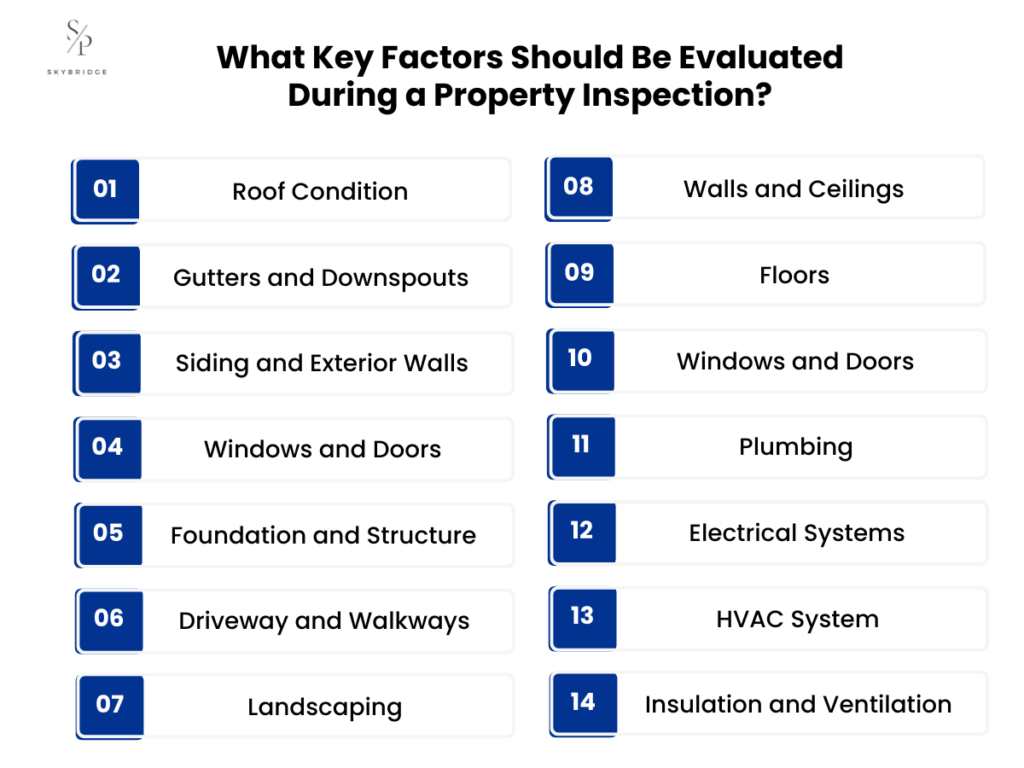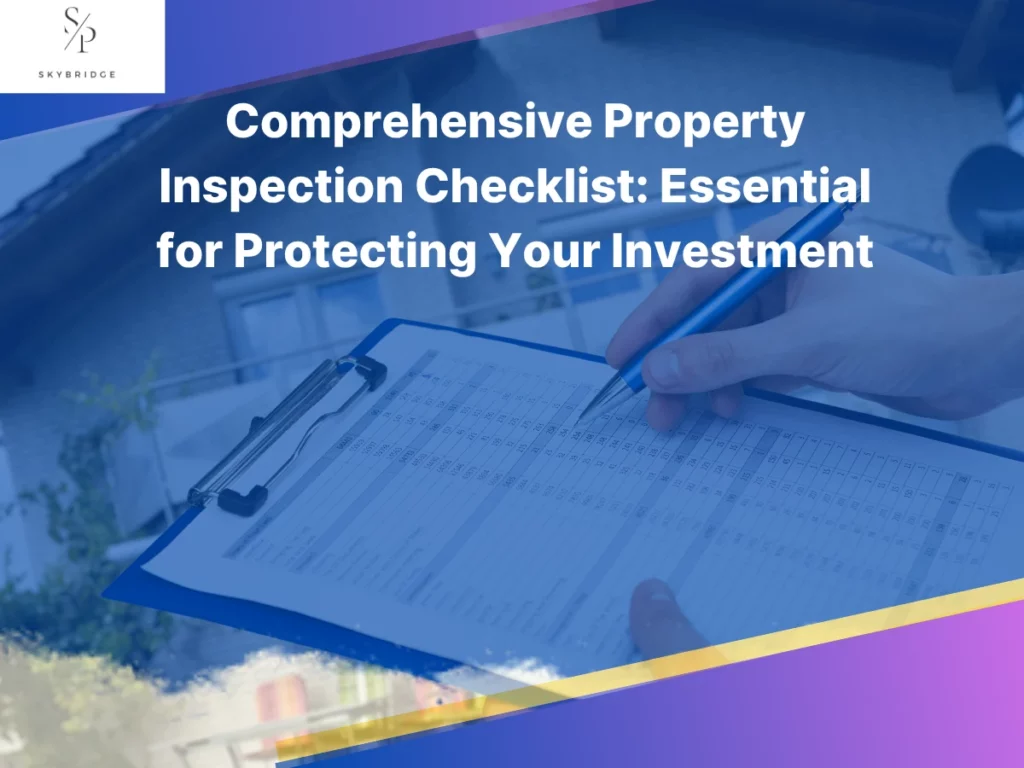What is a Property Inspection Checklist?
A property inspection checklist is a reliable tool for evaluating a property’s condition before purchase, lease, or ongoing maintenance. Whether it’s a single-family home, condo, or commercial facility, the checklist ensures all key components, such as roofing, plumbing, structure, and safety systems, are examined thoroughly.
Used by inspectors, property managers, and real estate professionals, it helps identify risks, uncover hidden issues, and verify compliance with safety and building standards. It translates observations into clear next steps, including immediate repairs, long-term maintenance, or budgeting considerations.
The checklist covers both exterior and interior areas, including roofing, siding, foundation, driveways, landscaping, plumbing, electrical systems, HVAC, insulation, and ventilation. As part of a broader property management checklist, it also includes checks for smoke detectors, pests, mold, radon, and lead paint, along with a review of structural integrity, repair history, and compliance records. A final summary confirms structural soundness, highlights major repairs, and outlines estimated costs. By standardizing the evaluation process, the checklist supports reliable evaluations, leads to lower repair surprises, and promotes greater investment protection through consistent documentation and informed decision-making.

What Are The Key Factors That Should Be Evaluated During a Property Inspection?
1. Exterior Inspection
An exterior inspection evaluates the condition of the roof, gutters and downspouts, siding and exterior walls, windows and doors, foundation, driveways, and landscaping to detect structural damage, weathering, or water-related issues. Each area is briefly assessed to flag visible signs of deterioration, improper drainage, or surface wear that may affect structural integrity or safety. The findings guide further detailed evaluation and help prioritize follow-up inspections or repairs.
Roof Condition
The roof is one of the most critical components to inspect, as damage here often leads to costly water intrusion and insulation failure. A detailed evaluation includes examining the roof surface, drainage features, and attachment points for evidence of material fatigue, storm damage, or structural weakness. Based on this evaluation, specific problem areas are flagged for maintenance or repair.
Key elements to assess include:
- Missing, cracked, or curling shingles
- Water stains on attic sheathing or interior ceilings
- Rusted or loose flashing around chimneys or vents
- Blocked or damaged ventilation outlets
- Pooling water or sagging on flat roof sections
Gutters and Downspouts
Efficient water management starts with fully functional gutters and downspouts, which play a key role in protecting the building’s siding, foundation, and basement from water damage. Inspectors examine these components for clogs, wear, and drainage direction to ensure rainwater is being diverted safely away from the structure to evade erosion or water infiltration at the base of the structure.
Watchpoints during inspection include:
- Debris buildup or leaf blockages
- Disconnected or sagging gutter runs
- Missing or undersized downspout extensions
- Cracks or corrosion in gutter sections
- Drainage paths that direct water toward the building
Siding and Exterior Walls
Siding and walls protect the internal structure from the elements, making damage here a potential entry point for moisture and pests. Inspectors evaluate siding material condition, sealant performance, and visual signs of weather-related degradation. Findings in this area often indicate the need for sealing, repainting, or material replacement.
Common issues to check for include:
- Surface cracks, holes, or warping
- Peeling or blistered exterior paint
- Rotted or deteriorated wood trim or panels
- Gaps along panel joints or corners
- Mold, algae growth, or moisture streaks
Windows and Doors
Exterior windows and doors are tested for function, weather resistance, and overall condition. Any difficulty in opening, visible gaps, or warped frames can indicate deeper sealing or alignment issues that affect energy efficiency and moisture control.
Specific inspection targets include:
- Cracked glass or fogging between window panes
- Warped or decayed wooden frames
- Worn, missing, or brittle weatherstripping
- Misaligned hinges or locks
- Evidence of air or moisture leaks at the edges
Foundation and Structure
The building’s structural base is inspected for cracks, movement, or water intrusion, including sloping floors, stair-step cracks, or moisture stains. Issues may stem from shifting soils, poor drainage, or inadequate backfill. Signs of past repairs can indicate prior problems and suggest the need for further structural assessment.
Typical red flags include:
- Horizontal, vertical, or stair-step foundation cracks
- Uneven or sloping interior floors above crawl spaces
- Water seepage near the base of the walls
- Gaps between siding and foundation
- Sagging or bowed beams under structural loads
Driveway and Walkways
As extensions of the building’s exterior, driveways and walkways play a vital role in maintaining safe access and proper site drainage. Inspections focus on identifying surface damage, uneven grading, and early signs of soil displacement that could lead to safety hazards or structural drainage issues if left unaddressed.
Key inspection areas are:
- Surface cracks, potholes, or crumbling edges
- Improper grading that channels water toward the building
- Heaved sections caused by root intrusion
- Water pooling after rainfall
- Settlement gaps in the ear steps or the garage apron
Landscaping
Well-managed landscaping not only enhances curb appeal but also protects the building envelope by controlling moisture and soil conditions. Vegetation patterns, grading, and irrigation systems are evaluated to determine whether they support proper drainage and building ventilation or pose risks to the structure through contact or moisture retention.
Important conditions to assess include:
- Tree limbs or shrubs touching the building exterior
- Bare soil, root exposure, or signs of erosion near the foundation
- Blocked or redirected drainage paths
- Broken, leaking, or misaligned sprinkler systems
- Debris accumulation around vents or base structures
2. Interior Inspection
An interior inspection assesses walls and ceilings, flooring, windows and doors, plumbing, electrical infrastructure, HVAC systems, and insulation and ventilation to verify functionality, safety, and overall condition. Each area is briefly evaluated for signs of structural wear, system failure, or inefficiency. Issues such as leaks, cracks, faulty wiring, or poor airflow are flagged for further investigation or maintenance to help preserve interior comfort and operational integrity.
Walls and Ceilings
Defects in walls and ceilings often serve as early indicators of deeper structural or moisture-related problems. Cracks, stains, or sagging surfaces often point to deeper issues like roof leaks or settling foundations. Inspections focus on both surface condition and potential underlying causes that may require repair or further investigation.
Common inspection points include:
- Cracks along drywall seams or corners
- Water stains or bubbling paint
- Mold or mildew around the ceiling edges
- Peeling paint or sagging drywall
- Holes or punctures from past repairs
Floors
Flooring conditions offer insights into both structural and moisture-related issues. Warped wood or lifted tiles often suggest moisture intrusion from plumbing leaks or rising damp. Uneven transitions may indicate settling, subfloor issues, or improper installation methods. The inspection evaluates how floor materials respond underfoot, checking for bounce, softness, or slope that could point to weakened joists or compromised supports.
Typical items inspected include:
- Warped or buckling hardwood or laminate
- Loose or cracked tiles
- Uneven flooring transitions between rooms
- Water-damaged or stained surfaces
- Signs of sloping or floor bounce
Windows and Doors
Windows and doors are essential for indoor comfort, energy efficiency, and structural sealing. Difficulty in opening or closing often stems from frame distortion caused by humidity, shifting walls, or wear at hinge points. Gaps or visible daylight around edges indicate compromised seals, which can allow moisture and air infiltration. These components are tested for alignment, hardware stability, and thermal performance.
Key aspects to evaluate include:
- Sticking or misaligned doors and windows
- Drafts or daylight visible around frames
- Cracked or damaged glass panes
- Loose or squeaky hinges and latches
- Missing or worn-out weather seals
Plumbing
The plumbing system is reviewed for both function and integrity, focusing on visible supply and drain lines, fixture performance, and signs of leaks. Persistent dripping, corrosion, or musty odors may signal deteriorating pipework or trapped moisture behind walls. Special attention is given to water pressure, drainage flow, and any discoloration that could indicate rust or contamination.
Areas typically checked include:
- Dripping faucets or pipe joints
- Slow-draining sinks, tubs, or showers
- Water stains under sinks or around baseboards
- Corrosion or rust on exposed piping
- Signs of mold near plumbing fixtures
Electrical Systems
Electrical safety is assessed through visual inspection and functional testing. Outlets and switches are checked for proper grounding and operation, and the service panel is reviewed for overloaded circuits or outdated parts. Signs like discoloration, buzzing, or heat near fixtures may signal fire risks. These checks help confirm system safety, code compliance, and capacity.
Key inspection tasks involve:
- Testing of outlets and light switches
- Checking breaker panel labeling and performance
- Identifying exposed or frayed wiring
- Noting hot or discolored outlets or switch plates
- Verifying the presence of GFCI outlets in wet areas
HVAC System
Heating, ventilation, and air conditioning systems are tested to confirm consistent performance, airflow quality, and operational safety. Dust buildup, short cycling, or temperature disparities can suggest poor maintenance or internal wear, such as blower motor issues or duct blockages. Thermostat behavior and air distribution are also evaluated to ensure system responsiveness and balance across zones.
Inspection points often include:
- Dirty or clogged air filters
- Weak airflow from vents
- Unresponsive or inaccurate thermostats
- Visible rust or debris inside furnace/AC units
- Excessive noise during operation
Insulation and Ventilation
Effective insulation and ventilation are critical for regulating indoor climate and controlling moisture. Inadequate insulation may cause heat loss in winter or overheating in summer, while poor ventilation can lead to condensation buildup and mold growth. The inspection looks at material coverage in attics, the function of exhaust fans, and air circulation pathways to ensure thermal and humidity control.
Important elements to assess include:
- Missing or compressed insulation in attics
- Drafts around attic hatches or access panels
- Blocked or ineffective exhaust fans
- Signs of condensation on windows or ceilings
- Stale air or musty odors indicating poor airflow
3. Safety and Environmental Inspections
To identify health hazards and ensure residential safety, safety, and environmental inspections assess critical elements such as smoke and carbon monoxide detectors, fireplaces, pest infestation, mold and moisture presence, radon levels, and potential lead-based paint exposure. Each component is checked for functionality, regulatory compliance, and risk factors that could affect indoor air quality or occupant well-being. The findings help determine whether preventive maintenance, remediation, or further testing is necessary before property transfer or habitation.
Smoke and Carbon Monoxide Detectors
Early detection of fire and gas hazards depends on the proper installation and functionality of smoke and carbon monoxide detectors. Inspectors verify that each unit is correctly placed according to local code, responds to testing, and is either battery-supported or hardwired. Units nearing expiration or blocked by paint or debris are noted for replacement.
Key items to verify include:
- Proper placement in hallways and bedrooms
- Working test/reset function on each unit
- Functional backup batteries or hardwiring
- Expiry dates on detector labels
- Absence of obstructions or paint over units
Fireplaces and Chimneys
Fireplace safety begins with clean and intact ventilation systems. During inspection, specialists examine the chimney structure for soot accumulation, flue damage, and airflow restrictions that could lead to smoke backflow. The firebox, damper, and hearth are also reviewed to ensure they’re free from cracks or deterioration that may pose fire risks.
Key inspection points include:
- Creosote buildup in the ideal chimney flue
- Cracked firebricks or a damaged firebox
- Loose or missing chimney caps
- Obstructions from nests or debris
- Deterioration in mortar or flue lining
Pest Infestation
Signs of pest activity can indicate structural vulnerabilities or sanitation issues within a property. The inspection process involves scanning for droppings, chew marks, or nesting material, especially in less visible areas like crawlspaces, insulation layers, or behind utilities. Rodent and insect pathways are documented to support future treatment or sealing efforts.
Common indicators include:
- Droppings in cabinets, basements, or attics
- Chewed wiring, insulation, or wood framing
- Entry holes along baseboards or siding
- Insect wings, tunnels, or frass near wood
- Musty odors or scratching sounds in the walls
Mold and Moisture
The presence of mold or excessive moisture can signal underlying plumbing issues, poor ventilation, or previous water damage. Moisture-prone zones are examined using visual inspection and basic detection tools. Where persistent humidity, staining, or biological growth is noted, follow-up with professional remediation may be recommended.
Key areas to inspect include:
- Visible mold growth on walls or ceilings
- Water stains or bubbling paint
- High humidity levels or condensation
- Leaking pipes behind walls or under sinks
- Inadequate exhaust fans in wet rooms
Radon Levels
Radon testing is crucial in evaluating air quality, particularly in homes with basements or slab foundations. A qualified assessor checks for test history, assesses likely gas entry points, and determines whether mitigation systems are functioning or needed. Homes without documented tests are often advised to undergo a current evaluation.
Inspection considerations include:
- Availability of previous radon test results
- Placement of test devices in the basement or slab areas
- Proper test duration and conditions
- Identification of entry points (cracks, joints)
- Assessment of existing radon mitigation systems
Lead Paint
In older homes, lead paint inspections focus on paint stability and exposure risk. The evaluation centers on deteriorating surfaces in high-contact areas, such as windows and door frames. Where visual evidence of chipping or dust accumulation is present, further testing is often advised, especially in pre-1978 constructions.
Key concerns during inspection include:
- Peeling or chalking paint on walls or trim
- Dust accumulation near windows or door frames
- Deteriorated surfaces in high-contact areas
- Lack of lead disclosure documentation
- Recommendations for testing or remediation
4. General Structural Integrity
The general structural integrity inspection evaluates the overall stability of the property, focusing on components like the foundation, load-bearing structures, and evidence of water damage, pest activity, or mold impact. This step helps determine whether the property is sound for continued use or occupancy, or if major structural repairs are required. Observations in this section guide decisions around reinforcement, remediation, or further specialist assessment.
Overall Condition
The property’s overall condition is reviewed to identify structural wear, shifting, or signs of past damage that could affect safety or performance. This includes assessing walls, ceilings, support beams, and roofing systems. Findings here help determine whether the structure is stable, aging appropriately, or in need of major renovation or reinforcement.
Key aspects to evaluate include:
- Cracks in load-bearing walls or ceilings
- Sagging rooflines or framing misalignment
- Bowing or separation in structural walls
- Signs of water intrusion or previous repairs
- Gaps between framing and foundation joints
Pests and Infestations
Active or historic infestations can compromise structural elements like framing, subfloors, and insulation. Evaluators check for damage caused by termites, rodents, or insects, particularly in hidden or moisture-prone areas. Structural weakening from chewing, nesting, or tunneling can indicate deeper risks to long-term property integrity.
Inspection points include:
- Hollowed or tunneled wood near framing
- Droppings or nesting in insulation or walls
- Gnawed wires or structural components
- Frass or discarded insect wings
- Entry points near crawl spaces or attic vents
Mold and Moisture
Persistent moisture inside structural cavities can weaken framing and contribute to mold colonization. This review targets attics, crawl spaces, and wall interiors for dampness or biological growth. Conditions like poor ventilation or past flooding are key triggers for mold-induced deterioration in structural materials.
Key items to assess include:
- Mold growth on structural framing or sheathing
- Dark stains on wood joists or beams
- Musty odor in enclosed areas
- High humidity in attics or basements
- Discoloration or decay at the subfloor level
Foundation Damage
The foundation is assessed for movement, cracks, and signs of settling that could compromise the structural load path. Minor hairline cracks may be cosmetic, while larger shifts often suggest structural instability. Soil erosion, moisture accumulation, and aging materials are typical contributors to foundation failure.
Common signs to identify include:
- Horizontal or step cracks in foundation walls
- Separation between walls and floors
- Uneven or sagging interior flooring
- Gaps in perimeter joints or corners
- Standing water or erosion at the base
5. Documentation and Records
Reviewing documentation and records provides critical insight into the property’s repair history, warranty coverage, and compliance with building codes. These records help verify the quality of past maintenance, identify any unpermitted modifications, and confirm that the property meets legal standards. Accurate documentation supports risk assessment, resale value, and planning for future repairs.
Repair History
A complete repair history reveals patterns of wear, recurring issues, and the overall maintenance quality of the property. Reviewers analyze service logs, contractor invoices, and dated work orders to trace structural or system-related fixes. This record helps anticipate future costs and assess how proactively the property has been maintained.
Key records to examine include:
- Roof replacement or patch documentation
- Plumbing or HVAC service logs
- Structural repair reports or inspection findings
- Recurring issues in the same systems
- Major upgrades with dated receipts or invoices
Warranty Information
Warranty coverage is reviewed to understand which parts of the property are still protected against defects or breakdowns. Inspectors review original purchase contracts, manufacturer warranties, and third-party service agreements. This step determines whether repair costs might be reduced or avoided through valid claims.
Important items to review include:
- Active warranties for HVAC, roofing, or appliances
- Start and end dates of each warranty
- Coverage details (parts, labor, exclusions)
- Transferability clauses or registration proof
- Claim process instructions and provider contact
Building Codes and Compliance
Verifying compliance with building codes ensures the property meets safety, zoning, and legal standards. This includes confirming that past renovations were properly permitted and inspected. Non-compliance can result in costly retrofits or failed transactions during resale or refinance.
Key areas to confirm include:
- Permit records for past structural or system work
- Certificates of occupancy or inspection approvals
- Documentation of code violations or abatements
- Evidence of unpermitted additions or modifications
- Compliance with fire, electrical, and plumbing codes
5. Final Checklist
The final checklist provides a complete summary of the property’s structural integrity, system performance, compliance status, and estimated repair costs. This last stage helps verify that all critical areas have been inspected and documented. It supports informed decision-making by confirming the property’s readiness for sale, occupancy, or future investment planning.
Is the Property Structurally Sound?
Structural soundness of property is evaluated by reviewing key load-bearing elements for cracks, shifts, or weaknesses that could compromise stability. Inspectors focus on the foundation, roof framing, and structural walls. Any visual signs of movement, misalignment, or long-term stress are flagged to determine whether further engineering evaluation is needed.
Key elements to assess include:
- Foundation cracks or settlement lines
- Bowing or leaning structural walls
- Sagging roof trusses or ridge beams
- Uneven floor levels or soft spots
- Gaps at load transfer points
Are There Any Major Repairs Needed?
Major repairs of a property are identified by compiling all critical defects found across the inspection. This includes structural issues, system failures, or safety concerns that require immediate or high-cost intervention. The list helps prioritize repairs and calculate post-inspection liabilities for buyers or property managers.
Common major issues include:
- Roof leaks requiring replacement
- Plumbing failures or pipe corrosion
- Electrical hazards or outdated panels
- Foundation instability or wall movement
- HVAC unit failure or inefficiency
Have All Major Systems Been Inspected?
Before finalizing, it is essential to confirm that all major systems, including plumbing, electrical, HVAC, and insulation, have been thoroughly evaluated. Missing or incomplete inspections could leave hidden defects undetected. Review documentation and field notes to verify full system coverage and whether specialized follow-up is needed.
Checklist items to confirm include:
- Complete inspection notes on plumbing and water supply
- Electrical load testing and breaker panel evaluation
- HVAC airflow, filter, and thermostat check
- Insulation and attic ventilation verification
- Any referrals to licensed trades for further assessment
Does the Property Meet Legal Safety and Building Standards?
Legal compliance is reviewed to ensure the property aligns with current fire, electrical, structural, and occupancy regulations. This step prevents potential fines, delays in resale, or permit complications. Inspectors confirm whether key safety elements meet code or require updating.
Important checks include:
- Smoke and CO detector placement and functionality
- Up-to-date permits for prior renovations
- Handrail, egress, and fire exit compliance
- Electrical panel labeling and grounding
- Plumbing, venting, and drainage standards
What Is the Estimated Cost for Repairs or Upgrades?
The total estimated cost for common property repairs and upgrades ranges between $10,000 and $85,000+, depending on the property’s condition and the scope of issues uncovered during inspection. Homeowners should also plan to spend 1% to 4% of their home’s value annually on ongoing maintenance to avoid future capital-intensive repairs.
Estimating repair and upgrade costs is essential to create a realistic budget and avoid financial surprises after the inspection. Accurate projections allow property owners or buyers to plan effectively, negotiate sale prices, or secure funding based on the true condition of the property.
Cost assessments are calculated based on the scope of repairs identified, factoring in materials, labor, permits, and whether specialized services are required. For example, foundation repairs can range from $2,200–$8,600, while HVAC replacements typically fall between $5,000–$16,000. A plumbing overhaul might cost $3,000–$15,000, depending on the extent of pipe corrosion or fixture replacement.
These estimates help stakeholders determine whether the property requires immediate capital investment or if repairs can be deferred. A typical budget buffer of 10–15% is recommended for hidden or evolving issues. The outcome is a reliable cost framework that supports negotiation, decision-making, and long-term financial planning.
Why a Property Inspection Checklist is Crucial for Property Owners?
A property inspection checklist is vital because it ensures no critical system or structure is missed during evaluation, helping owners avoid costly oversights and preserve long-term property value. It provides a systematic framework for reviewing essential areas across any residential or commercial building.
Core benefits of using a property inspection checklist include:
- Standardized evaluation across exterior, interior, and structural elements
- Early detection of hidden issues like moisture intrusion or electrical faults
- Clear documentation for repairs, budgeting, or resale planning
- Support for safety compliance (e.g., smoke detectors, lead paint, radon testing)
- Consistent maintenance tracking for multi-property portfolios
- Reduced risk of unexpected repair expenses or code violations
- Improved transparency during transactions or tenant transitions
Building on these checklist-driven benefits, Skybridge Property Group ensures that every inspection is methodical, complete, and aligned with long-term property goals. Our property inspectors assess all major systems, including roofing, HVAC, plumbing, foundation, and safety features, to uncover issues and document early across Los Angeles, Diamond Bar, Pomona, Rowland Heights, and La Puente. This enables owners to prioritize repairs, budget accurately, and preserve the long-term value of their property.







